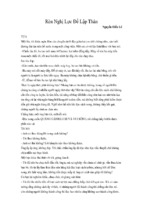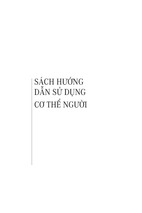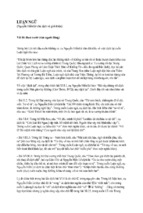Build Your Own
Wooden
Dummy
Carlos Colorado
Wing Chun Kung Fu Council
Copyright (C) 2001 WCKFC
www.wckfc.com
All Rights Reserved
No part of this book may be reproduced in any form whatsoever, whether by graphic, visual, electronic, film,
microfilm, tape recording, or any other means, without prior written permission of the author, except in the case of
brief passages embodied in critical reviews and articles.
Published by Wing Chun Kung Fu Council in cooperation with Grandmaster Ip Ching
Distributed by:
WCKFC
545 E. Tabernacle
St George Ut 84770
www.wckfc.com
Printed in the United States of America
CONTENTS
About The Dummy
9
Selecting The Proper Wood
11
Building The Body
12
Building The Arms
23
Building The Leg
26
Particulars Of A Proper Dummy
29
Finishing The Dummy
31
Setting Up The Dummy
32
The Measurements
34
introduction
ABOUT THE
WOODEN DUMMY
The Mook Yan Jong is, in many
ways, the trademark of Wing Chun
training. It is a vital key of a
practitioners skill. In order to
properly train and become
proficient, one must have a
wooden dummy that properly
represents correct lines of force,
and that has the correct amount of
spring. There are several ways to
make a Mook Yan Jong. These
instructions assume that you
already have some proficiency in
using tools, and working wood.
Please read the instructions in their
entirety before you start making
your wooden dummy, so that you
may have a basic idea of all that is
involved. As always, remember to
use common sense, and be
conscientious of safety measures;
wear safety glasses, etc.
Following these instructions will
leave you with a beautiful and
functional, heirloom quality
wooden dummy. And it will
provide you the correct angles, as
taught by Ip Man, through his son
Ip Ching.
chapter one
SELECTING THE PROPER
WOOD
The first step in building a good
wooden dummy is selecting a
wood that is both functional, and
beautiful. It must meet the
required measurements.
In choosing a piece for the body,
one has different options. One
may decide to use a natural log
from a variety of trees, or perhaps
a laminated and milled log from
the wood of choice. Most
practitioners choose to use
hardwood, however, experience
shows that a lodge pole (pine) log,
which is more readily available,
will hold up excellently against
years of use; many hesitate to use a
pine log because of the inevitable
checks and cracks on the wood.
Although it is important to find a
log without excessive cracks that
might distort the angles on the
dummy, the checks on a
thoroughly cured log do not affect
the function of the dummy. Some
even like the look of wood better
with a few cracks to add character.
One always has the option of
filling in the cracks with wood
putty if the cracks are thought of
as an eyesore. Opting for pine
rather than hardwood will make
the project all the more affordable,
if that is a concern.
As for the limbs and crosspieces,
the wood must be a hardwood, for
example, oak, teak, maple, etc.
chapter 2
BUILDING THE BODY
This is a must so that your dummy can
withstand the tremendous amount of power
and impact that it will recieve.
The first step to building the body of the Jong
is to cut the log to the desired length. The
neater the cut, the less one will need to sand at
the end of the project. Be sure to also choose
the face or front of the body, taking into
account the amount and size of checks
running through it.
The next step is to mark a vertical midline
down the front of the body, then a line on
the top end of the dummy that extends
from the first line, through the core line of
the body, all the way to the back.
Using these lines as the main guides,
draw where the holes for the three
arms and the leg will be, as shown on
the plans.
A very suitable angle is
achieved if when marking off the top
two arm holes, one allows there to be
a 3/16 gap between the inside of the
hole, and the vertical midline of the
dummy, or a 3/8 gap between the
holes. This is a suggestion that will
greatly improve the usefulness of the
dummy.
Note from the plans at the back
of this book that the two top armholes
must cross the transverse plane seen
on the top of the dummy. It is crucial
to not make these two holes parallel to
each other. Follow the next steps
carefully in order to avoid such a
mistake.
Lay the body horizontally. It is important whenever drilling a hole, to be
sure that the body is level.
Center the topmost armhole when seen from
above. Do NOT place the dummy with the
vertical midline in the center when seen
from above, offsetting one armhole to each
side of the center of the body, as shown in
this photo.
Using a long 1-1/2 boring bit,
drill a pilot hole, which will be the
center of the armhole, for the first
and topmost arm all the way
through the dummy. Such a bit
will produce a nice, clean, and
straight hole; and it will save you
much chiseling, but if a bit that
size is unavailable, you may use
one of a smaller diameter.
Next, Begin to carefully chisel the
square shape of the hole and
continue chiseling down all the
way through the body.
Great care must be taken while
chiseling, in order to keep the hole
from wandering off from where it
should be.
If very long chisels are unavailable,
youll have to draw the shape of
the hole on the back of the dummy.
Use the pilot hole that you drilled,
to determine the exact position of
the hole, and once youve cut in as
far as your chisel will take you,
start the same process from the
back of the dummy. Your two
holes, pertaining to the same arm,
should meet in the middle.
Once youve
completed the first and
topmost armhole,
rotate the dummy,
centering the hole for
the second arm.
Follow the procedure
as you did for the top
armhole.
Be aware that since there is no
distance between the bottom of the
first armhole, and the top of the
second, the two holes will literally
meet in the middle of the dummy,
creating a diamond shaped
passage from one hole to the other.
Repeat the process for
the last armhole in the
same way as the two
previous steps.
The hole for the leg on the Mook
Yan Jong, must be slanted at a
14° slope. To achieve this, your
pilot hole must be made using a
wooden guide. One can easily
be made by drilling a hole with
the boring bit into the end of a
3x 2x 2 block of wood.
Then, using a miter saw,
cut off both ends of the
block at the prescribed
14° angle.
Now place the guide on
the log as shown and
commence drilling your
pilot hole. Once youve
drilled a couple of inches
into the body of the Jong,
you may set aside the
guide. At this point, the
first couple of inches on
your hole will serve as a
guide as you drill the rest
of the leg hole. If your
boring bit is of a small
diameter, you may wish
to drill a couple of pilot
holes.
With a pilot hole drilled,
chiseling out the rest of the
hole is much like chiseling
the armholes, except one
must be careful to create this
hole with the 14° angle. The
wooden guide you created is
useful in this process. Use
the guide by laying it on the
surface of the body, at the
top of the leg hole and begin
chiseling out the hole.
Then move the guide to the bottom
of the hole and use the back edge
of the guide, begin chiseling out
the bottom of the leg hole. This
process will help you start the leg
hole at the correct angle.
With the holes for the limbs in
place, one is ready to make the
holes for the crosspieces that will
hold up the Mook Yan Jong.
First draw a line
perpendicular to the
line youve drawn on
the top of the body.
Then extend this line
down the side of the
body.
Mark the holes as
shown on the plans at
the back of this book.
Be sure that the holes
are off centered and
toward the back of the
dummy. You cannot,
however, use a 1-1/2
boring bit. Youll
have to go with a
smaller one. Drill a
pilot hole and chisel
out the corners as you
did with all the
previous holes.
- Xem thêm -





















